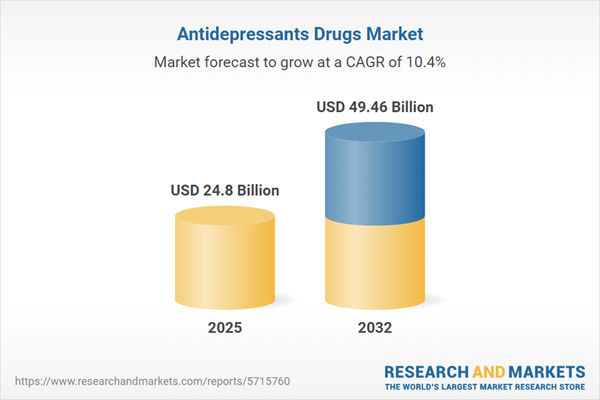Speak directly to the analyst to clarify any post sales queries you may have.
The Antidepressants Drugs Market is experiencing pivotal change as industry leaders seek adaptive strategies to manage shifting clinical and regulatory demands while maintaining operational excellence. Forward-thinking organizations leveraging innovation and technology are better positioned to address evolving patient needs and regulatory requirements in this dynamic landscape.
Market Snapshot: Antidepressants Drugs Market Size and Trends
The global Antidepressants Drugs Market demonstrates robust growth, with an estimated value of USD 22.44 billion in 2024. The market is projected to increase to USD 24.80 billion in 2025, potentially reaching USD 49.46 billion by 2032, delivering a compound annual growth rate (CAGR) of 10.38%. Key market drivers include increased investment in advanced mental health therapies and modernization across regulatory and care-delivery models. Technology adoption is amplifying patient access, while providers implement agile operating strategies to meet rising demand. The pipeline of innovative drug candidates and expanding engagement models underline the industry’s shift toward resource-efficient, patient-focused solutions amid evolving care and payment structures.
Scope & Segmentation of the Antidepressants Drugs Market
This report gives senior decision-makers a comprehensive view, supporting strategic differentiation within the Antidepressants Drugs Market. Rigorous segmentation explores actionable trends and potential for sustainable growth across several dimensions:
- Drug Class: Comparative insights span atypical antidepressants, monoamine oxidase inhibitors, selective serotonin reuptake inhibitors, serotonin noradrenaline reuptake inhibitors, and tricyclic antidepressants, aiding evaluation of treatment frameworks and partnership avenues within varying clinical indications.
- Product Type: Includes both branded and generic formulations, emphasizing analysis of pricing, market access, and fit for different providers and delivery settings.
- Administration Route: Covers oral, parenteral, and transdermal therapies, each providing opportunities for varied clinical adoption and supporting better adherence across healthcare settings.
- Distribution Channel: Highlights hospital and retail pharmacies as well as online channels, examining reach, accessibility, and their capability to serve emerging digital and consumer demand patterns.
- Therapeutic Application: Reviews indications including bipolar depression, generalized anxiety disorder, panic disorder, post-traumatic stress disorder, major depressive disorder, obsessive compulsive disorder, and seasonal affective disorder, to guide informed planning for clinical and commercial initiatives.
- Regional Segmentation: Considers the Americas, Europe, Middle East & Africa, and Asia-Pacific; evaluating how regulatory and reimbursement variations shape market strategies and influence entry or expansion efforts.
- Companies Covered: Features market leaders such as Eli Lilly and Company, Pfizer Inc., AbbVie Inc., GlaxoSmithKline plc, H. Lundbeck A/S, Otsuka Pharmaceutical, Johnson & Johnson, Teva Pharmaceutical, Sun Pharmaceutical Industries, and Cipla Limited, with a focus on competitive differentiation, alliances, and regional positioning.
Key Takeaways for Decision Makers
- Broader therapeutic portfolios are enabling organizations to address more treatment gaps and enhance positioning in mental health care delivery.
- Personalized medicine, supported by pharmacogenomics, is redefining care pathways and creating value in patient outcomes.
- The progressive adoption of digital health and telemedicine is facilitating improved care coordination, expanding access, and fostering scalable treatment models that align with changing regulations.
- Innovative drug delivery methods, such as extended-release and patient-centric formats, are optimizing adherence and resource allocation in high-need populations.
- Rising use of generic antidepressants compels firms to focus on clinical and brand differentiation, as well as on effective product lifecycle strategies.
- Partnerships with contract development and manufacturing organizations are enhancing supply chain resilience and operational compliance in a complex market environment.
Tariff Impact on the Antidepressants Drugs Market
Recent adjustments to United States pharmaceutical tariffs are encouraging companies to increase supplier diversity, invest in domestic production, and modernize manufacturing processes. These measures promote supply chain stability and enable organizations to sustain operations despite evolving regulatory and commercial pressures with broader impact across the Antidepressants Drugs Market.
Methodology & Data Sources
This analysis uses robust quantitative modeling, in-depth executive interviews, comprehensive market surveys, and expert evaluation of regulatory and academic materials. By integrating these sources, the report draws actionable conclusions aligned with the needs of senior market participants.
Why This Report Matters
- Equips executive teams to anticipate regulatory shifts and market evolution, fostering agility in strategic responses within the antidepressant segment.
- Delivers intelligence to support investment planning, resource optimization, and risk assessment for market expansion and operational continuity.
- Strengthens organizational resilience with an emphasis on compliance, risk controls, and distribution strategies that keep pace with industry dynamics.
Conclusion
Long-term growth in the Antidepressants Drugs Market will rely on innovative strategies and proactive adaptation. Leaders can use these actionable insights to achieve operational stability and meet the challenges presented by ongoing industry transformation.
Additional Product Information:
- Purchase of this report includes 1 year online access with quarterly updates.
- This report can be updated on request. Please contact our Customer Experience team using the Ask a Question widget on our website.
Table of Contents
3. Executive Summary
4. Market Overview
7. Cumulative Impact of Artificial Intelligence 2025
Companies Mentioned
The companies profiled in this Antidepressants Drugs market report include:- Eli Lilly and Company
- Pfizer Inc.
- AbbVie Inc.
- GlaxoSmithKline PLC
- H. Lundbeck A/S
- Otsuka Pharmaceutical Co., Ltd.
- Johnson & Johnson
- Teva Pharmaceutical Industries Ltd.
- Sun Pharmaceutical Industries Ltd.
- Cipla Limited
Table Information
| Report Attribute | Details |
|---|---|
| No. of Pages | 186 |
| Published | November 2025 |
| Forecast Period | 2025 - 2032 |
| Estimated Market Value ( USD | $ 24.8 Billion |
| Forecasted Market Value ( USD | $ 49.46 Billion |
| Compound Annual Growth Rate | 10.3% |
| Regions Covered | Global |
| No. of Companies Mentioned | 11 |









